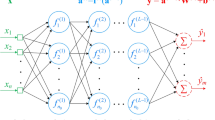Abstract
This article describes a multilevel neural architecture based on SOMs and radial basis function networks, which can produce results and approximation of functions close to those obtained using a single radial basis function network. In addition, the learning algorithm of this new architecture delivers a very significant reduction in the training time of the network and, at the same time, allows parallelization techniques to be applied in a natural way. The proposed training system is not an iterative method, it is not exactly an exact one. Our proposal procedure requieres an amount of time similar to the iterative methods but with the efficiency of the exact methods. This architecture has been developed to test on problems involving ecological segmentation, as part of environmental study and monitoring programmes by research groups in southeastern Spain.



Similar content being viewed by others
References
Brassard PG (1995) Fundamentals of algoritmics. Prentice Hall, New Jersey
Broomhead DL (1988) Multivariable functional interpolation and adaptive networks. Complex Syst 2:321–355
Cabello Pardos E (2004) Técnicas de reconocimiento facial mediante redes neuronales, Universidad Politécnica de Madrid
Corne SA, Carver SJ, Kunin WE, Lennon JJ, Van Hees WWS (2004) Predicting Forest attributes in southeast Alaska using artificial neural networks. For Sci 50(2):259–276
de Felipe J (1997) Microcircuits in the Brain. In: Proceeding of the IWANN’97, pp 1–14
Golbabai A, Mammadov M, Seifollahi S (2008) A new strategy for training RBF network with applications to nonlinear integral equations. IUST Int J Eng Sci 19(5–2):1–7
Haykin S (1994) Neural Networks, a Comprehensive Foundation, IEEE press, New Jersey
Jacobs RJ (1991) A competitive modular connectionist architecture. Adv Neural Inf Process Syst 3:767–773
Jun L, Duckett T (2008) Some practical aspects on incremental training of RBF network for robot behavior learning, intelligent control and automation. WCICA 2008:2001–2006
Kohonen T (1990) Self-Organizing Maps. Springer, Berlin
Kuo RJ, Hu TL, Chen ZY (2011) Integration of SOM network and evolutionary algorithms to train RBF network for forecasting. Int J Innov Comput Inf Control 7(4):1959–1970
Liu B, Li AH, Wang CL, Wang JB, Ni YT (2011) SOM and RBF networks for Eddy current nondestructive testing. Adv Res Inf Sci Autom Material Syst 219–220:1093–1096
Mark Allen W (2000/2004) Estructuras de datos en Java, Addison-Wesley, Boston
Nabney IT (1999) Efficient training of RBF networks for classification Artificial Neural Networks. In: Ninth International Conference of ICANN 99. (Conf. Publ. No. 470), vol 1, pp 210–215
Park BJ, Pedrycz W, Oh SK (2010) Polynomial-based radial basis function neural networks (P-RBF NNs) and their application to pattern classification. Appl Intell 32(1):27–46
Poggio T (1990) Networks for approximation and learning. IEEE 78:1481–1497
Robert S (1984) Algorithms. Addison-Wesley Longman, Boston, MA, USA
Sharaf R, Noureldin A (2007) Sensor integration for satellite-based vehicular navigation using neural networks. IEEE Trans Neural Netw 18(2):589–594
Shin HJ, Eom D-H, Kim S-S (2005) One-class support vector machines—an application in machine fault detection and classification. Comput Ind Eng 48(2):395–408
Sun J, Xu W, Liu J (2006) Training RBF Neural Network Via Quantum-Behaved Particle Swarm Optimization. In: Neural Information Processing, Lecture Notes in Computer Science 4233:1156–1163
Torres Arriaza JA, Guindos Rojas FG, Peralta López M, Garbín MC (2003) An automatic cloud-masking system using Backpro neural nets for AVHRR scenes. IEEE Trans Geosci Remote Sens 41(4)
Venu Gopala Rao K (2005) Soft computing-neural networks ensembles. J Theor Appl Inf Technol 2:45–50
Wu M, Zhang W, Wang X, Luo D (2009) Applications of MODIS satellite data in monitoring water quality parameters of Chaohu Lake in China. Environ Monit Assess 148(1–4):255–264
Xiong QY, Shi WR, Sun Y, Fan M, Xie Z (2003) Constructive RBF structure by using self-organizing maps. In: 7th World Conference on Systemics, Cybernetics and Informatics, vol V. Proc Comput Sci Eng 1:335–339
Yang JS, Wang YQ, August PV (2004) Estimation of land surface temperature using spatial interpolation and satellite-derived surface emissivity. J Environ Inform 4(1):27–44
Yang B et al (2005) Condition classification of small reciprocating compressor for refrigerators using artificial neural networks and support vector machines. Mech Syst Signal Process 19
Acknowledgments
This study was financed from Project TIN2010-15588 of the Spanish Ministry for Science and Innovation.
Author information
Authors and Affiliations
Corresponding author
Additional information
Communicated by D. Liu.
Rights and permissions
About this article
Cite this article
López, F.J.M., Arriaza, J.A.T., Puertas, S.M. et al. Multilevel RBF to resolve classification problems with large training sets: new pseudo-exact procedure. Soft Comput 18, 2245–2252 (2014). https://doi.org/10.1007/s00500-013-1197-1
Published:
Issue Date:
DOI: https://doi.org/10.1007/s00500-013-1197-1




